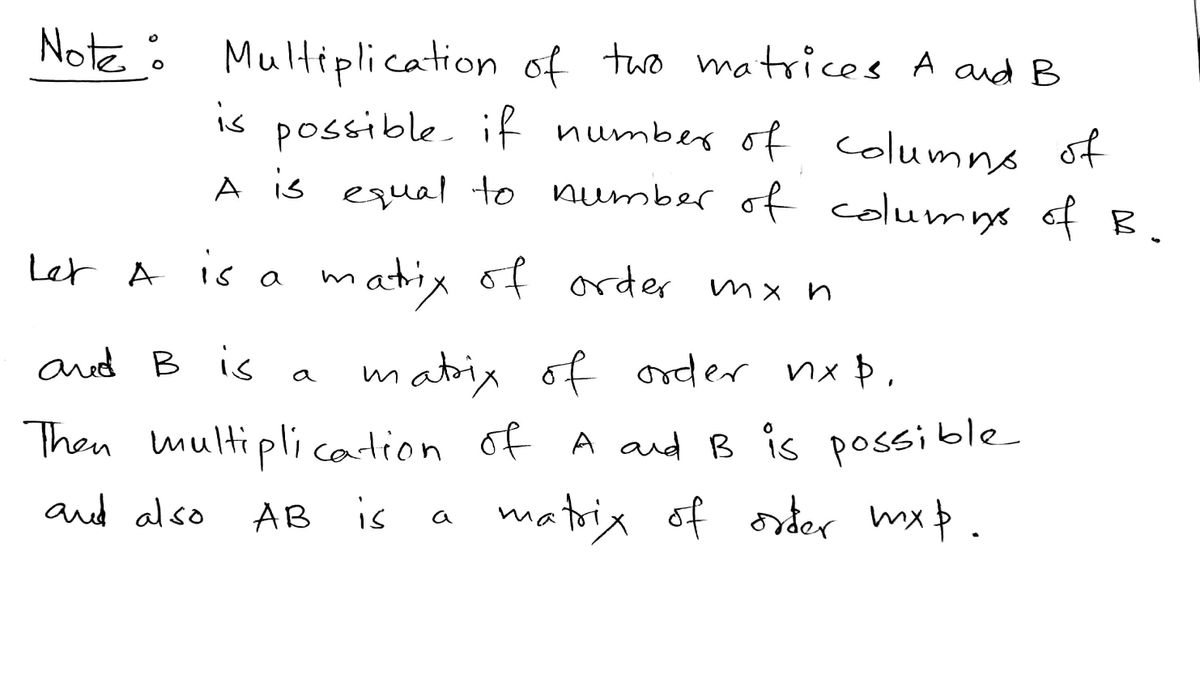0 H -3 to multiply these matrices in this order Given the matrices A == A. It is not possible 3-3 2 2 and and B -1 -1 -4, B. If multiplication is possible what is AB -
0 H -3 to multiply these matrices in this order Given the matrices A == A. It is not possible 3-3 2 2 and and B -1 -1 -4, B. If multiplication is possible what is AB -
Advanced Engineering Mathematics
10th Edition
ISBN:9780470458365
Author:Erwin Kreyszig
Publisher:Erwin Kreyszig
Chapter2: Second-order Linear Odes
Section: Chapter Questions
Problem 1RQ
Related questions
Question
![**Given the Matrices:**
Matrix \( A \):
\[
A = \begin{bmatrix} -3 & -3 & 2 \\ -1 & -1 & -4 \end{bmatrix}
\]
Matrix \( B \):
\[
B = \begin{bmatrix} 0 \\ -1 \\ -3 \end{bmatrix}
\]
**Question A:**
It is **not possible** to multiply these matrices in this order.
**Question B:**
If multiplication is possible, what is \( AB \)?
*Explanation:*
- **Matrix \( A \)** is a \( 2 \times 3 \) matrix (2 rows, 3 columns).
- **Matrix \( B \)** is a \( 3 \times 1 \) matrix (3 rows, 1 column).
To multiply two matrices, the number of columns in the first matrix must match the number of rows in the second matrix. In this case, multiplication is possible because matrix \( A \) has 3 columns and matrix \( B \) has 3 rows.
The resulting product \( AB \) will be a \( 2 \times 1 \) matrix.](/v2/_next/image?url=https%3A%2F%2Fcontent.bartleby.com%2Fqna-images%2Fquestion%2F410204a0-8764-4473-a9c2-14bad68c17f5%2F637a9bcf-d27a-4c63-9618-e73fc4512a88%2F390tce_processed.jpeg&w=3840&q=75)
Transcribed Image Text:**Given the Matrices:**
Matrix \( A \):
\[
A = \begin{bmatrix} -3 & -3 & 2 \\ -1 & -1 & -4 \end{bmatrix}
\]
Matrix \( B \):
\[
B = \begin{bmatrix} 0 \\ -1 \\ -3 \end{bmatrix}
\]
**Question A:**
It is **not possible** to multiply these matrices in this order.
**Question B:**
If multiplication is possible, what is \( AB \)?
*Explanation:*
- **Matrix \( A \)** is a \( 2 \times 3 \) matrix (2 rows, 3 columns).
- **Matrix \( B \)** is a \( 3 \times 1 \) matrix (3 rows, 1 column).
To multiply two matrices, the number of columns in the first matrix must match the number of rows in the second matrix. In this case, multiplication is possible because matrix \( A \) has 3 columns and matrix \( B \) has 3 rows.
The resulting product \( AB \) will be a \( 2 \times 1 \) matrix.
Expert Solution
Step 1

Step by step
Solved in 2 steps with 2 images

Recommended textbooks for you

Advanced Engineering Mathematics
Advanced Math
ISBN:
9780470458365
Author:
Erwin Kreyszig
Publisher:
Wiley, John & Sons, Incorporated

Numerical Methods for Engineers
Advanced Math
ISBN:
9780073397924
Author:
Steven C. Chapra Dr., Raymond P. Canale
Publisher:
McGraw-Hill Education

Introductory Mathematics for Engineering Applicat…
Advanced Math
ISBN:
9781118141809
Author:
Nathan Klingbeil
Publisher:
WILEY

Advanced Engineering Mathematics
Advanced Math
ISBN:
9780470458365
Author:
Erwin Kreyszig
Publisher:
Wiley, John & Sons, Incorporated

Numerical Methods for Engineers
Advanced Math
ISBN:
9780073397924
Author:
Steven C. Chapra Dr., Raymond P. Canale
Publisher:
McGraw-Hill Education

Introductory Mathematics for Engineering Applicat…
Advanced Math
ISBN:
9781118141809
Author:
Nathan Klingbeil
Publisher:
WILEY

Mathematics For Machine Technology
Advanced Math
ISBN:
9781337798310
Author:
Peterson, John.
Publisher:
Cengage Learning,

